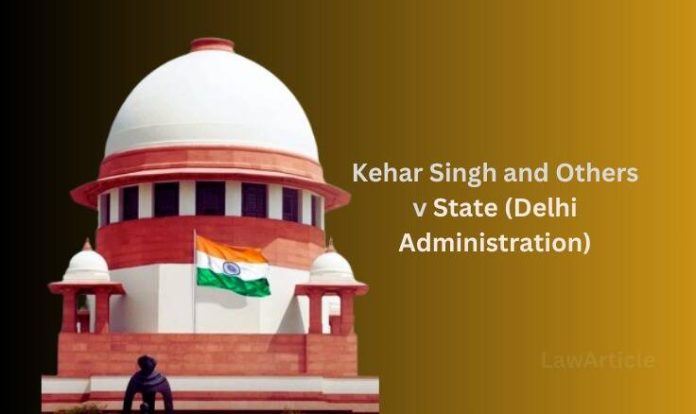Kehar Singh and others v. State (Delhi Administration) 1988
Introduction
The case of Kehar Singh and Others v. State (Delhi Administration) is a landmark judgment delivered by the Supreme Court of India, dealing with the assassination of the then-Prime Minister of India, Indira Gandhi. This case examines the application of conspiracy law, the role of circumstantial evidence in criminal proceedings, and the administration of the death penalty. The case remains pivotal in Indian jurisprudence for its exploration of individual culpability within a collective criminal act.
Background of the Case
On October 31, 1984, Prime Minister Indira Gandhi was assassinated by her bodyguards, Satwant Singh and Beant Singh. The assassination was allegedly a retaliation against the Prime Minister for ordering Operation Blue Star, a military action against the Golden Temple in Amritsar. While Beant Singh was killed on the spot, Satwant Singh was apprehended. Later, Kehar Singh, Satwant Singh’s uncle, and Balbir Singh were also arrested and charged with conspiracy to murder Indira Gandhi.
Trial and High Court Proceedings
The trial was held at the Sessions Court, where Kehar Singh, Satwant Singh, and Balbir Singh were convicted of conspiracy and murder under Sections 120B, 302, and 34 of the Indian Penal Code. All three were sentenced to death by the Sessions Court. The Delhi High Court upheld the convictions and the death sentences of the accused ([1987] AIR Delhi 257).
Supreme Court Appeal
The case was appealed to the Supreme Court of India, where several legal issues were deliberated:
- Conspiracy and Common Intention: The central question was whether Kehar Singh and Balbir Singh were part of a conspiracy to assassinate the Prime Minister. The prosecution alleged that Kehar Singh instigated and motivated the assassins, thereby playing a crucial role in the conspiracy.
- Admissibility of Evidence: The defense argued that the evidence presented against the accused was primarily circumstantial and lacked direct proof of involvement in the conspiracy.
- Fair Trial: Concerns were raised about the impartiality of the trial process, given the high-profile nature of the case and the public sentiment against the accused.
Arguments by the Prosecution and Defense
Prosecution’s Argument
– Motive and Instigation: Kehar Singh was deeply involved in instigating and encouraging the actual assassins, Satwant Singh and Beant Singh, to commit the murder. This was supported by testimonies that highlighted his meetings with the assassins before the assassination, where he allegedly expressed satisfaction over the idea of assassinating Indira Gandhi.
– Circumstantial Evidence: The prosecution relied on a chain of circumstantial evidence, including witness testimonies and the behaviour of the accused, to establish a connection between Kehar Singh and the conspiracy.
– Conspiracy Meetings: The prosecution argued that Kehar Singh attended several meetings with the assassins and other co-conspirators, where they discussed the plan to assassinate the Prime Minister.
Defense’s Argument
– Lack of Direct Evidence: The defense argued that there was no direct evidence linking Kehar Singh to the conspiracy. The prosecution’s case was based on hearsay and unreliable witness testimonies.
– Fair Trial Concerns: The defense raised issues regarding the trial’s fairness, citing the intense public and political pressure to convict the accused.
-Questioning the Reliability of Witnesses: The defense questioned the credibility of the prosecution’s witnesses, arguing that their testimonies were inconsistent and contradictory.
Supreme Court’s Decision
The Supreme Court, in its judgment ([1988] 3 SCC 609), upheld the convictions and the death sentences of Kehar Singh and Satwant Singh. The Court made the following observations:
The Court held that the evidence presented by the prosecution sufficiently established Kehar Singh’s involvement in the conspiracy. The Court noted that a conspiracy is generally proved by circumstantial evidence, as it is often hatched in secrecy.
The Supreme Court emphasized that the chain of circumstantial evidence was complete and pointed unequivocally towards the guilt of Kehar Singh. The Court cited previous rulings to highlight that circumstantial evidence can be as convincing as direct evidence if it satisfies certain criteria (e.g., Sharad Birdhichand Sarda v. State of Maharashtra, [1984] 4 SCC 116).
The Court justified the death penalty, stating that the assassination of the Prime Minister was an act of treachery and warranted the highest punishment under the law. The Court found that there was insufficient evidence to prove Balbir Singh’s involvement in the conspiracy and thus acquitted him.
Significance and Impact
The case of Kehar Singh and Others v. State (Delhi Administration) is significant for several reasons:
- Jurisprudence on Conspiracy: The judgment provides a comprehensive analysis of the law on criminal conspiracy, especially in the context of political assassinations. It underscores the importance of circumstantial evidence in establishing conspiracy and the legal standards that need to be met.
- Death Penalty Debate: The case reignited the debate on the death penalty in India, particularly concerning its application in cases involving political figures. It raised questions about the role of the judiciary in balancing the demands of justice with the rights of the accused.
- Fair Trial and Media Influence: The case highlighted the challenges in ensuring a fair trial in high-profile cases, where public sentiment and media coverage can influence the proceedings.
- Precedent for Future Cases: The principles laid down in this case continue to influence the judicial approach to conspiracy cases and the use of circumstantial evidence in criminal trials.
Conclusion
The Supreme Court’s decision in Kehar Singh and Others v. State (Delhi Administration) reaffirms the principles of criminal law concerning conspiracy and collective intent. It serves as a critical precedent for understanding the application of the death penalty and the evidentiary standards required in criminal proceedings. The case remains a cornerstone in the study of Indian criminal law, reflecting the complexities involved in prosecuting high-profile crimes and the judiciary’s role in upholding the rule of law.
Also Read:
Rights of undertrial prisoners in India
How To Send A Legal Notice In India


